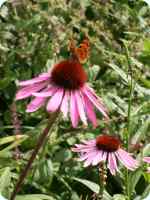
Newsletter
Autumn 2009

 |
Newsletter |
 |
Time is a very strange commodity. When you are young there are yawning gaps when nothing happens; you are in limbo, always waiting. I am not sure at which age it changes, but as years pass so time becomes more precious and it races away. I have barely put all the plants in the right or wrong place in the borders and it is time to whip them out, or cover them in straw to protect them. The season of catalogue reading is here, but the sun is shining and we are enjoying a late dry summer.
I have temporarily laid down the fork and taken up the catapult. The lawn looks as if someone is plotting the celestial pattern of the stars on it and keeps making mistakes. I rush out each morning, remove the walnuts and fill in the holes, then I wait with ammunition in hand. So far the enemy is winning and I need more practice to hit my moving targets. A foray up the border leads me to my second burst of rude words. Who is digging these enormous holes in my beds, generally on top of something precious, and then leaving me a gift I do not want? By the size of the gift it could be an elephant! This visitor is jolly clumsy. He/she always heads for the nursery area so they can knock over a few pots or plod through some delicate young cuttings. My third problem - the birds cause much repetition of gardening activities. I weed and plant the bulbs; they arrive and uproot them all. I sweep the paths; they must clear the worms and beetles along the path edge again. I thought I had created enough barriers to keep the hens at bay, but on a recent reconnaissance mission I discovered they have a Houdini ability to get through very narrow railings after assailing the tall brick wall. Who said gardening was fun?
Back to our Programme. We are at the end of a very memorable year for the Worcestershire Group. We have enjoyed excellent lectures; a big thank you to Leila Mantle and Wendy Richards for organising them so efficiently. Our first outing was to Dial Park where Olive Mason and her husband made us welcome. It was very well supported by the group. Sue Chitty managed to get the best weather of the month for our trip to Hampton Court and Stockton Bury, and David surpassed himself with our long weekend in Dorset. All these are recorded in more detail in the newsletter. We managed two out of three coffee mornings, one rained off. It is a great pleasure to be invited into such beautiful gardens for a morning; thank you to all who have volunteered.
The whole year has been leading up to one weekend in September when we hosted the National Autumn Weekend for the HPS. We did discuss starting with a Study Day, but Vivienne told us we were capable of far more! So Vivienne and John McGhee, David Pollitt and Judith Doughty have worked their cotton socks off to make it the success it turned out to be. I would like to thank all the members of our group who have helped in some way. We have had about 50% of our members involved. It was great fun and fascinating to meet so many members from other groups. Sue Pinsent has written to all of you thanking you for making the weekend go with a swing. Her letter is on the board.
This busy year has passed so quickly. For what lies in store for us next year come to the meetings. One thing I know, it will be fun.
Apologies to those who signed up for the propagation workshop. Despite my best endeavours I have so far been unable to get Pershore College to commit to a firm date. It is clear that following the merger with Warwickshire their resources have been hopelessly overstretched and we will just have to be patient. The current expectation is that the workshop will be held in the spring of next year. I will let all know as soon as I have any firm news.
'Season of mists and mellow fruitfulness' wrote John Keats about autumn: it's been a season of great bounty for a Newsletter Editor, with a large number of contributions. So, thank you to all of you who have written for this edition, which also includes the paperwork for the AGM, which, since the change to the financial year, will be in March. I would especially like to thank Leila, who has printed the colour centre pages. This has been for this edition only, so if anyone else feels able to offer for the spring edition, I would be glad to hear from you. You might like to know that Jenny Constant's cover drawing shows the Malvern Hills and Priory through the pleached cercis at Spetchley, with asters and other late summer flowers, representing The Picton Garden, below. If any of you have any comments about the newsletter, please get in touch with me - it is, after all, your newsletter with your thoughts and writing, so I hope you'll be able to continue to send contributions in the future. The copy date for the spring edition is 13 February.
No doubt each of us has our own interpretation of what constitutes a thug, or a colonizer, and in many ways the one is synonymous with the other, but with seeders there can be no argument. Based on my own experience of growing, and sometimes rejecting, plants over the years, the following is my list of candidates to be categorised in one or other of these ways. I am excluding tree and shrubs as, mostly, they grow from a single woody stem and do not present the same problems.
Climbers contain a surprising number of thugs. The territorial ambitions of Rosa 'Rambling Rector' and Rosa 'Kiftsgate' are legendary, as is the Russian vine Fallopiabaldschuanica, but personally, I have never grown them. However I do grow a Virginia Creeper - Parthenocissus quinquefolia which is extremely vigorous, and needs clipping back regularly in the growing season in order to keep it within prescribed bounds. Its autumn colour, although only short-lived, is eye-catching.
Another climber which has thuggish tendencies is wisteria. Turn your back and fail to carry out the recommended pruning routine, and its whippy growths will have vaulted the guttering and disappeared several feet under the roof tiles. Not a good idea to allow this to continue un-redressed. I seem to remember that the answer to a quiz question, as to what is the largest plant in the world, is a wisteria, somewhere in America. It would be America, wouldn't it?
Clematis montana varieties need watching too, as they can suddenly spring 20ft or more into a suitable host tree.
It is amongst the hardy perennials that inexperience and lack of knowledge can catch you out. For example, I bought a Bidens aurea 'Hannay's Lemon Drop' from a nursery sales' table, because I rather liked the pale yellow and white flowers, not to mention the name, only to discover the following year that it is stoloniferous and was shooting up, not only some distance from its original position, but, more awkwardly, amongst neighbouring plants as well. It had to go and I have spent some time trying to get rid of it. The label, of course, does not help the innocent as the nursery wants to make a sale, and is hardly likely to incorporate a warning - 'This plant is a THUG', or even a milder form of wording. In similar circumstances when gardening in Surrey, I fell for the guiles of Epilobiumangustifolium 'Album', and afterwards had considerable difficulty in removing it, although, in fairness, John Cook, who at the time was running Green Farm Plants, did say in his catalogue 'an enthusiastic colonizer'. I would just add - and how!
Others to be careful of are the lysimachias, all of which, apart from L. ephemerum, which is a very well behaved plant, tend to run around and come up where they are not wanted, as do many of the euphorbias and griffithii variants in particular. Crocosmias and Anemone japonica are other colonizers which expand quickly.
I find some of the taller, back of the border, perennials tend to be somewhat pushy. Eupatorium purpureum (Joe Pye Weed), Leucanthemella serotina and Helianthus 'Lemon Queen', are all excellent plants but need dividing every two or three years to keep them under control.
I was caught out by a grass-like reed species with an attractive variegated blade called Phragmites australis variegata, which, I only discovered too late, behaves like Gardeners Garters, well known for its rampant habit of growth. I am still working on its total eradication.
Seeders, although they can be irritatingly persistent, are, in most cases, easier to deal with than thugs and colonizers. Here, Enemy No. l for me, is the wild celandine, Ranunculus ficaria, which hops over the fence from the quaintly named 'Tadpole Alley', a public footpath which shares a boundary with us, and is the very devil to get rid of. Its defence mechanism is for the stem to break off when you are trying to yank it out, leaving the small bulb in the ground, only to re-appear next year. Their saving grace is that the top growth vanishes completely before midsummer.
Bluebells may be at risk in the wild, but in the garden environment, if allowed to, they will quickly multiply and like the celandines need deep digging, very deep digging, to extract the bulbs. I am working hard to eliminate them.
The common yellow Corydalis lutea is next in order of nuisance value, where it seems every seed germinates, even in the most unlikely spots, and if allowed, swiftly goes on to adulthood, followed by flowering and yet more progeny. I have been waging war on this one since we moved here. More attractive is the somewhat similar white flowered C. Ochroleuca and better behaved regarding seeding, although still generous.
Lamiums are thuggish seeders in any conditions and need watching, whilst linarias will establish themselves just about anywhere, and, if allowed, will elbow their neighbours to one side in their search for space. Erigeron karvinskianus, with its small daisy-like flowers is an AGM plant and therefore, presumably, worthy of doffing one's hat to, but is also a prodigious seeder, and, if unchecked, will soon spread itself around the garden.
Primroses also seed generously including into the lawn, but the mower soon takes care of their ambitions in this area. Alchemilla mollis is another well-known seeder which quickly establishes deep roots if not removed in infancy. I find the yellow Potentilla recta 'Warrenii', which incidentally is a very garden worthy plant, seeds about, as does Geranium pyrenaicum 'Bill Wallis' but these are welcome.
Finally I would mention two biennials - Galactites tomentosa, a variegated thistle with a striking presence in both its pale mauve and white forms, and Cerinthe purpurascens, the 'In' plant a few years back, which happily seed if the flower heads are not removed.
Perhaps, whilst being wary, we should be grateful for many of these thugs and colonizers as they are strong reliable plants, and in the case of seeders, can provide us with a useful supply of plants for the sales table. So it's not all bad.
On the outing to North Wales last year we bought a Clematis patens 'Korean Moon' from Crug Farm Plants to add to our collection. When planting it out I noticed a small 2-inch seedling growing in the pot with the clematis. At first I thought it was a weed, and was about to tweak it out, but closer inspection showed it was either an unrecognisable, somewhat exotic, weed or, more likely, given the provenance of Crug Farm, something else, which could prove to be interesting.
I potted it up and put it in the greenhouse where it grew strongly to about 3ft tall but did not produce any flowers. Come the winter it looked a bit sad, so I cut it down and forgot about it. In the spring I decided it was a waste of space and I would get rid of it, but.... when I emptied the pot, lo and behold a large tuber! With interest re-kindled I re-potted it and grew it on. It is now a substantial plant some 3ft by 2ft and started producing single mauve-coloured 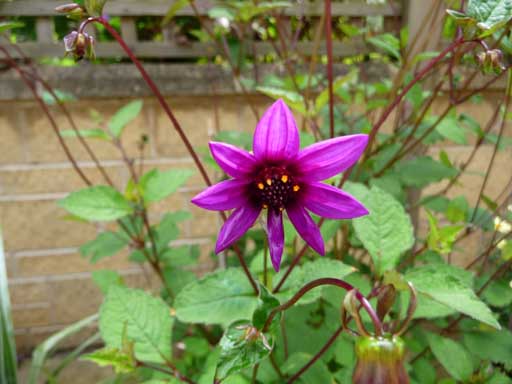 flowers on long stalks at the beginning of July. Every indication pointed to it being a dahlia, probably one of the rather obscure (to me) collection listed in Crug Farm's catalogue. A call to the nursery confirmed that it was most likely Dahlia aff (aff = affinity to) purpusii BSWJ10321. Certainly better than an exotic weed and a very worthwhile additional plant.
flowers on long stalks at the beginning of July. Every indication pointed to it being a dahlia, probably one of the rather obscure (to me) collection listed in Crug Farm's catalogue. A call to the nursery confirmed that it was most likely Dahlia aff (aff = affinity to) purpusii BSWJ10321. Certainly better than an exotic weed and a very worthwhile additional plant.
It was as long ago as May 2007 that Vivienne McGhee proposed to the Committee that the Group should host a national event for the HPS and that a small sub-committee was established. The HPS guidelines on staging a national event run to twelve A4 pages of small print. Reading this document it quickly became clear that a small group such as ours would struggle to manage a full Autumn Weekend. A Study Day was the most we felt we could aspire to. So how, why and when did we eventually find ourselves organising an Autumn Weekend?
was established. The HPS guidelines on staging a national event run to twelve A4 pages of small print. Reading this document it quickly became clear that a small group such as ours would struggle to manage a full Autumn Weekend. A Study Day was the most we felt we could aspire to. So how, why and when did we eventually find ourselves organising an Autumn Weekend?
There was probably no single defining moment and the decision was certainly influenced by the close attentions of Anne Wood, the then HPS Events Organiser, who was keen to find a host for 2009 after cancellation of the previous year’s event. Vivienne’s vision and commitment was a major factor. She felt that the traditional format of HPS weekends was “tired” and that the time had come to try something new. A hybrid of a study day and a conventional autumn weekend evolved as a concept for the event and produced the name “Autumn Study Weekend”.
Our original idea of running a study day had been based on the subject of Asters, drawing on the expertise of local National Collection Holder, Paul Picton, whose Colwall garden would be at its peak in late September. This, in turn, led to the idea of using the nearby Abbey Hotel in Malvern as a base. Options are limited when seeking accommodation for up to 200 guests and with its beautiful setting and conference facilities the Abbey was the ideal choice. A block reservation was made and Paul Picton booked to speak.
Two contentious speakers, working as a team, were engaged and the theme “The Role of Plants in Gardens” agreed for the Saturday of the weekend. Following a morning presentation and discussion each delegate visited two out of four contrasting gardens with the results being debated after the evening meal.
Most delegates found the day thought-provoking, if not stimulating, and the weekend overall was thoroughly enjoyed. Even the weather smiled on us. Our fears about a possible lack of manpower proved groundless as the membership rallied to the cause superbly. John McGhee and Judith Doughty deserve special mention and their tireless efforts guaranteed a seamless operation.
The reward for any project such as this lies in the enjoyment others derive from the outcome. We were richly rewarded. The venture, too, placed Worcestershire firmly on the HPS map and has given the Group a sense of cohesion and pride in a job well done. Was our concept a success and will the new format be adopted by others? Time will tell. Would we do it again? My role was peripheral and those who bore the brunt of the work, not to mention stress, might think otherwise but for my part I would vote “Yes”. It was a stimulating experience.
On a lovely hot Friday morning Wendy, Sheila, Martie and I met the Robin Hood coach (with driver Mike) at Webbs of Wychbold and introduced ourselves to the members and friends of the Staffordshire Group who had kindly invited our Group to join them for their annual weekend away. From the beginning they were all very welcoming and we soon felt part of the group.
Having loaded our luggage and the necessary crates in anticipation of bringing ‘one or two’ plants back, we set off down the M5. After an easy journey on the motorway we turned off onto the Devon roads which soon became very narrow and, not for the first time during the weekend, tested Mike’s driving ability to the utmost. Eventually we arrived at Cothay Manor and were soon enjoying the beautiful garden surrounding the spectacular 15th century house. The various ‘rooms’ are laid off a long yew walk, herbaceous borders, wild flower areas and a teardrop-shaped pond, all provide interest and the intended romantic feel. An additional attraction were the numerous Painted Lady butterflies which appeared in their hundreds, a sight which we were going to see frequently during the weekend.
Mid-afternoon saw us departing for Holbrook Garden at Sampford Shrubs. Described by the owners as ‘cutting edge naturalistic plantings and inspiration drawn from wild plant populations’ it did not appeal to me. However, the owners were very welcoming and there was a comprehensive nursery.
So, two very different gardens and we hadn’t even got to the hotel! Arriving in Bideford, Mike took us to the hotel which was out of the main town overlooking the River Torridge. It was extremely comfortable and provided very good food.
Saturday morning we departed for Marwood Hill, a spectacular garden which had been gradually extended into the countryside and now covers about 20 acres with spectacular views from the hillside over the valley. Herbaceous borders, lakes, shrubs, champion trees, all kept in excellent condition by head gardener Malcolm Pharoah who has been there since 1972. Unfortunately the National Collection of iris ensata was not in flower but this was more than made up for by the numerous candelabra primulas round the lakes. This was the most impressive garden we visited and I hope to get the opportunity to go back one day.
After lunch we moved on to Arlington Court (NT) – a pleasant garden consisting of extensive pleasure grounds and formal Victorian flower beds. Worth seeing is the National Trust Carriage Museum which occupies the old stables and houses more than 50 horse-drawn carriages.
We arrived back at the hotel in good time for dinner so the ‘Worcester Four’ decided to go to Appledore on the local bus. We spent a pleasant hour wandering along the promenade, where the North Devon Festival had started, and between the old fishermen’s cottages before retuning to Bideford. Bus passes come in very useful!
Sunday dawned, another cloudless morning, and after breakfast we set off for Rosemoor. The garden there is most inspiring. A hot garden was at its colourful best, the roses were giving out their lovely scent in the early summer heat, the lake, waterfall, potager and contrasting individual gardens were all worth seeing. Every area was exceptionally well cared for. The woodland walk provided some welcome shade and I thought it the best RHS garden I had seen. Another on the list for a return visit.
After lunch we travelled to a private garden of about one acre. A plantswoman’s garden, it contained various interesting features including a Japanese teahouse, koi carp pond, stream, bog garden and duck pond – a lot to see in such a small area. The owners provided cool drinks and we found some shade on what was an extremely hot afternoon.
We then moved on to a further three gardens in the small hamlet of Cherubeer. All three are owned by members of the same family and manoeuvring in the narrow Devon lanes gave Mike another headache but he again rose to the challenge and managed to get us safely in (and out) of the area. The largest garden of an acre was very pretty with herbaceous borders, woodland beds and a National Collection of hardy cyclamen. The other two gardens were much smaller, one surrounding a 15th Century thatched cottage.
Arriving back in good time for dinner, Wendy and I went for a walk along part of the Tarka Trail which follows 30 miles of old railway lines between Braunton and Meeth and passes by the hotel.
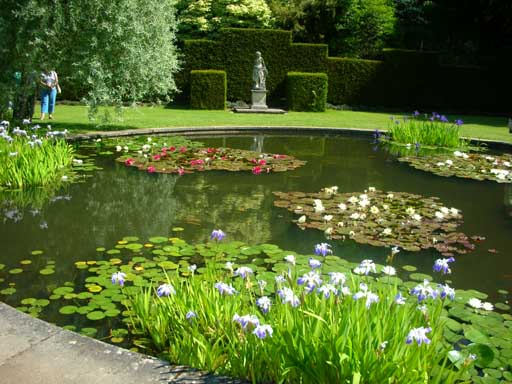 Leaving en route for home on Monday morning we made our way to Knightshayes Court (NT) which opened half an hour early for our party. I thought the garden here much more interesting to a Hardy Planter than Arlington Court. There are formal herbaceous borders, walks through ‘the garden in the wood’ and a beautiful pool. We were lucky to see this at its best: the water lilies were in flower as were the clumps of Japanese iris round the edge. A very good plant centre enabled us to add to the collection of goodies in the coach.
Leaving en route for home on Monday morning we made our way to Knightshayes Court (NT) which opened half an hour early for our party. I thought the garden here much more interesting to a Hardy Planter than Arlington Court. There are formal herbaceous borders, walks through ‘the garden in the wood’ and a beautiful pool. We were lucky to see this at its best: the water lilies were in flower as were the clumps of Japanese iris round the edge. A very good plant centre enabled us to add to the collection of goodies in the coach.
Finally we moved on to Hestercombe. I was really looking forward to visiting this garden again having been there several years ago on one of our group’s day trips. However, I was most disappointed. It was looking a little sad, possibly due to the huge construction project in progress, restricting access to some areas.
Unfortunate to finish on a down, but this did not detract from the overall enjoyment of the weekend. Good company, interesting gardens and the bonus of glorious weather. Thanks to the Staffordshire Group for the invitation. I wonder where they are going next year ?
My favourite colour is blue. With a wealth of plants considered to be blue, several years ago I decided to plant a blue and white bed to complement the 'hot' bed I had started to plant the previous year. White isn't too difficult! There were many white climbing roses to choose from to grow up the pillar l had in place. I already had cuttings of a middle-sized hebe with large white flower spikes. (Sadly no idea of its name). Three white delphiniums were purchased as very small plants. A beautiful white Agapanthus 'Polar lce' was already bursting out of its pot (bought from Liz and Kate a year or two ago) and was bedded out successfully. I had grown Agapanthus 'Headbourne hybrids' several years ago so planted three clumps (now reduced in size, they do like my soil!) and also planted a couple of clumps out of Agapanthus Navy Blue'. I had also grown some white platycodon and several were ready in pots in the cold frame. A nice white-flowered, variegated-leaved lamium was easy to plant and made itself at home very quickly, together with a lovely hardy white diascia purchased from Diane Cole. So, no problem with the whites in all shapes and sizes.
But blue! What a range of shades and tones. So many 'blues' are really, to my eye, more purple/lilac than true blue, Over the past few years I have come to the conclusion that true blue exists mainly amongst the Salvia family, although a few delphiniums and scabious, particularly S. 'Clive Greaves' come a good second. Salvia uliginosa has proved difficult on my dry sandy soil - but what a beautiful plant if one can grow it. Salvia patens is a 'good doer' and has proved quite hardy, Salvia 'Indigo Spires' has been quite spectacular and lasted outside for two winters, but I'm glad I took cuttings because the originals didn't last in the winter of 2008/09. Still, I had my cuttings ready in the greenhouse and they have thrived this summer - still flowering now - early October. I 'discovered' Strobilanthusatropurpurea when visiting Treasures at Tenbury a few years ago, but when I grew some plants from seed and put one in my bed - it looked distinctly purple! Still, it's a lovely plant and flowers quite late in the year so is very useful indeed. A couple of pretty herbaceous clematis were purchased - again more lilac than true blue, but well worth keeping nevertheless - Clematis integrifolia and C. x eriostemon 'Hendersonii' do well, plus the lovely hybrid C. 'Annabel'. Sadly C. 'Multi Blue' got clematis wilt and died in its first season. I must plant C. alpina instead to grow up the pillar to flower before the white rose blooms in June. Viola 'Eastgrove Blue' provided some lovely clumps of mid-blue at the front of the bed, and Aconitum carmichaeli flowers late in September so I found a place for one plant. (It gets large!)
This bed, like the 'hot bed', has changed over the past few years, it's constantly evolving and plants come and go, but I remain fond of anything that grows that is blue!
I had heard about a 'wonderful garden' called The Garden House at Buckland Monachorum, near Yelverton, in south Devon - so I decided on my August holiday whilst in Exmouth that I would definitely visit it. On arrival in Exmouth, I visited the Tourism Offices and was given information, a map and details of the once a week Sunday bus across Dartmoor. Also taxi numbers - if needed.
So next morning I was up early on the top of a double-decker bus, to Exeter. It was a glorious sunny day and I enjoyed the trip up and seeing for miles over the estuary, and I was full of happy anticipation and promise of a great day. Getting into Exeter was something of a shock, as the sun had been replaced by ominous clouds! I stood in a queue of people putting up their umbrellas and zipping anoraks up. Still, I wasn't going to let a few clouds spoil my day, or dampen my enthusiasm. Two hours on the bus would be plenty of time to retrieve the sun, and I was looking forward to seeing the ponies, the heather and gorse, sumptuous views and pretty villages.
As we travelled along, a terrible rainstorm started. People got on dripping wet and with 'inside-out' umbrellas. The bus driver went gamely forward, but the windscreen wipers could hardly cope, and despite my optimism and the prospect of this 'fantastic' garden, after an hour and a half I wondered if I'd ever see it! Later, as I rubbed the steamed-up window, I saw a sign for Yelverton. Briefly I wondered whether to stay on, keep dry and go to Plymouth! As this was the bus - returning two hours later - I got off.
Immediately I got soaked! I used my mobile to contact local taxis, but not surprisingly, all were taken. Plus the local taximan had, I was told, gone to Tenerife for a week......So I set off to walk to Buckland Monachorum, fending off the wind and rain with my umbrella. Amazingly, (and, of course, it was a Sunday), the Gods sent a taxi towards me. I flagged it down, it was available and soon I was on my way to The Garden House. I even managed to book a return trip with him, before he drove away. I now had the garden for two hours.
On my arrival the guides gave me a warm welcome - apparently they hadn't expected any visitors to turn up - so they had time to give me good information on the 'evolution' of The Garden House. I had read a pamphlet whilst I sat on the bus, so the pieces of info. began to form a general impression of what to expect as I went round. 'Good luck,' they said, showing me through the archway into the garden, 'Hope it improves....', and so I walked off into the dull warm mist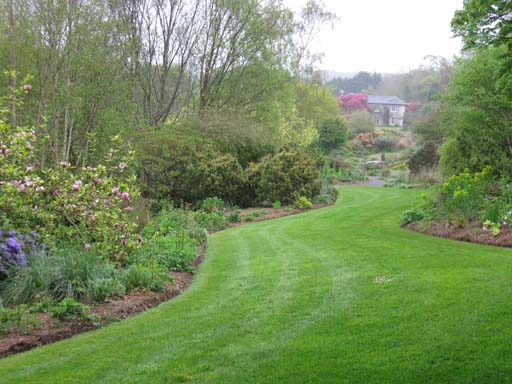 and found myself going down a very slippery woodchip path. I picked my way along, peering beyond my umbrella and at the same time trying to study my very wet map, torn and buffeted by the wind.
and found myself going down a very slippery woodchip path. I picked my way along, peering beyond my umbrella and at the same time trying to study my very wet map, torn and buffeted by the wind.
The eight-acre garden lies north-facing in the Longcomb Valley, not too far from Tavistock and 500 metres above sea level. It was home at one time for the vicars of Buckland Monachorum and by the 1700's the vicarage was a substantial three-storey building.
Slowly, very slowly, the wind and rain lessened and I could just see my way down to the romantic Walled Garden, with its remains of the buildings as treasures from the past. Here I saw a 15th century tower with a spiral staircase, with a view overlooking the Tennis Court Garden, a thatched barn which was used as a kitchen, and the Sunken Garden, which was being re-furbished. The Walled Garden had four terraces. The fact that it faced north and afforded no sun in the winter made this a very cold and wet spot needing to be given much thought and care. A 'modern' vicarage was built in the 1920's (now a tearoom). After the Second World War the garden was sold to a Lionel Fortescue and his wife Katherine, who between them began the creation of the garden for the next 40 years. They also had a market garden business. After their deaths in 1961, a Fortescue Garden Trust was set up to ensure the gardens and buildings would become an ongoing legacy for the future.
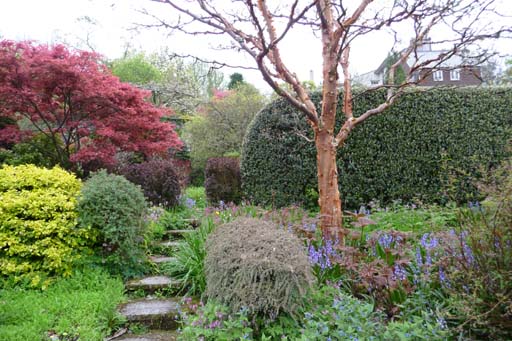 The Walled Garden with impressive wisteria sheltered various 'rooms' of hot, vibrant colour and had 8 foot long hedges along the paths. There were Cosmos 'Choca Mocha', penstemons, Agapanthus 'Alba', cyclamen hederifolia and rusty red daylilies, Dahlia 'Bishop of Llandaff', crocosmia, yellow poppies, nerines, hostas, geums ('Mrs Bradshaw'), Alstomeria 'Princess Leyla', Maltese cross and monardas; green Sedum 'Gooseberry Fool' and Sedum 'Red Setter' and lovely grasses of Miscanthus chinensis and dieramas from the July bedding, obviously a good year.
The Walled Garden with impressive wisteria sheltered various 'rooms' of hot, vibrant colour and had 8 foot long hedges along the paths. There were Cosmos 'Choca Mocha', penstemons, Agapanthus 'Alba', cyclamen hederifolia and rusty red daylilies, Dahlia 'Bishop of Llandaff', crocosmia, yellow poppies, nerines, hostas, geums ('Mrs Bradshaw'), Alstomeria 'Princess Leyla', Maltese cross and monardas; green Sedum 'Gooseberry Fool' and Sedum 'Red Setter' and lovely grasses of Miscanthus chinensis and dieramas from the July bedding, obviously a good year.
There was much wet, warm haze as I walked across the Tennis Court Lawn, the Oval Lawn and the Bowling Green Terrace, and as I walked onto a lower terrace I saw a granite archway, splendidly adorned with wisteria. I was impressed by the obvious care taken and neatness everywhere, and the beautiful herbaceous borders displaying impressive July/August planning and planting.
Gradually the clouds diminished and the rain stopped altogether. I could see the visitors entering the garden. It must have seemed quite magical for them to see it in such a good light. The leaves, petals and branches were by now sprinkled with raindrops and the light breeze, in combination, made the garden shimmer and glow with colour.
I enjoyed the South African Garden which sang with vibrancy. Such a mix of exciting colour blending - blue, navy and white agapanthus, pink and red Turk's Cap lilies, yellow and orange poppies, heleniums, sneezewort and sedum 'Frosty Morn', eucomis - the pineapple lily. The Formal Area was a lovely lawn, edged with trilliums and hellebores. The Quarry Garden (which had produced useful stone for the garden) and the Alpine Bank (mounded and upgraded with Cornish grit for good drainage). A romantic Cottage Garden, with its truly beautiful vista towards St Andrews Church in Buckland Monachorum, having the Caradon Hills as a backdrop, a magic Stone Circle made in 1994, reflecting local early Christian standing stones, an Acer Glade, presently being opened up for additional light in autumn, a Wildflower Meadow, with its path through, to enable you to 'walk' through it, leading to a path, crossed by bridges covered in wisteria, and on towards a thatched summer house and dovecote. Then onto a Spring Garden with a group of Cornus variegata (Wedding Cake Tree) which was placed very well.
On leaving, as I turned back before reaching the archway, I looked around and thought how impressive it was. Such variety and order in the planting, buildings and layout - such class! I was glad I'd gone to see it; it had everything I'd hoped to see. A garden that most people, if not all, who see it will actually fall in love with.
'To me, a lush carpet of pine needles or spongy grass is more welcome than the most luxurious Persian rug.'
This is just becoming a series of lists - but I hope that they may be of some help/interest when checking and learning the names of any new plants you may come across. In the last newsletter I gave examples of how the names of people who discovered a certain plant and the places where others come from, are 'Latinised' to describe some plants that we see quite often in our own gardens. Now here is a list showing how the growing habit of a plant can give the plant its botanical name. Some of them are glaringly obvious, one or two, not so -
| Arboreum | tree-like | eg Aeonium arboreum |
| Arundinacea | reed-like | eg Stipa arundinacea |
| Columnaris | upright habit | eg Chaemecyparis columnaris |
| Compacta | compact | eg Ilex glabra compacta |
| Erecta | upright habit | eg Tagetes erecta |
| Fastigiata | Erect and almost parallel branches | egTaxus baccata 'Fastigiata' |
| Horizontalis | Parallel to ground | eg Cotoneaster horizontalis |
| Pendula | Weeping/drooping | eg Betula pendula |
| Procumbens | scrambling/lying | eg Asarina procumbens |
| Pyramidalis | Cone or pyramidal | eg Campanula pyramidalis |
| Repens | Creeping | eg Rosmarinus repens |
Plant habitats also play a part in the naming of many plants, again, some are rather obvious, others not so, such as -
| Aquatica | Growing in or near water< | eg Mentha aquatica |
| Arenarius | Sandy habitat | eg Dianthus arenarius |
| Littoralis | sea shore | eg Griselina littoralis |
| Maritima | Near the sea | eg Armeria maritima |
| Montana | Mountainside | eg Clematis montana |
| Palustris | Marshy | eg Potentilla palustris |
| Rupestris | Amongst rocks | eg Viola rupestris |
Just to reiterate - plant names of various sorts are used by many people every day, for fruit, vegetables and flowers. Most people use common names with few problems, although some plants may have several common names depending upon the part of the country - or continent - in which they are native. Hence a botanical name can sometimes be of great importance in making sure one is talking about the same plant as someone from another part of the country. (I cited the different botanical names for bluebells when in England or Scotland or the USA for instance. )
Some of you may have already discovered a booklet on the Web, 'Plant Names - A Guide for Horticulturists, Nurserymen, Gardeners and Students'. It does get a bit technical for non-botanists (and old botanists!) but is well worth downloading and reading at leisure.
On the day of the best weather in July, we joined other members and guests for our outing to Herefordshire. Writing this in October, what do we remember of Hampton Court and Stockton Bury?
At Hampton Court, mostly designed from the start to be open to the public, the brilliance of eschscholzias against the softness of lavender; the disappointment of the view from the tower but the delight of the sunken garden on emerging from the darkness of the curved tunnel; the grandeur of the lawn and its trees. Then the restrained formality of the main garden with agapanthus in pots and lavender outlining the routes to the gazebos on islands - these a bit too dominant, but probably designed to hold a lot of visitors. There were more agapanthus in pots in the canal garden - this part of the garden doesn't quite work - too many pots, perhaps? A beautifully-planted blue and yellow border and restrained well thought-out planting in all the corners of the main garden, plus a superb Monarda 'Beauty of Cobham'. We ate our picnic near there, admiring the light on splendid allium seedheads. Very satisfying.
To Stockton Bury, a family garden, much extended over the years. Oasthouses now used as corndryers, an odd 'Roman picnic house'(?), a greenhouse of stunning pelargoniums, streptocarpus and aeoniums. Changes of level slope down to a series of ponds - lovely setting and plants beautifully grown. We admired some superb colours in small groups, but were disappointed that, looking along larger areas of border, the colours jarred and did not move in a pattern. But the echinaceas and hemerocallis were wonderful, and superbly placed, with just the right shade of colour for any of their settings. There was a beautiful little yellow, orange and blue area. And we did find the Secret Garden, and thought it a lovely place.
But, probably contrary to what most thought, we preferred the greater formality and measured colour of Hampton Court. Here are some photos - judge for yourself